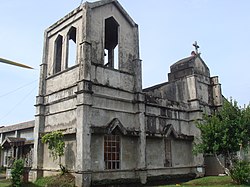Etymology
Although the original name was Payo, this town has changed name from Panganiban to Payo and back again. During the last term of the late assemblyman Francisco Perfecto, Panganiban became Payo again on April 20, 1957, under Republic Act No. 1654. [6] Congressman Jose M. Alberto (through Republic Act 2122 enacted without executive approval April 15, 1959 [7] ) changed the name to Panganiban again by which it is officially known at present.
According to legend, the town's early settlers elected a tribal chief whom they called “Payo” which could have been their vernacular term for headman. [8]
Geography
It is situated on the northern part of Catanduanes, with its eastern part facing the Pacific Ocean. It is bounded on the north by the municipality of Bagamanoc, on the south by the municipality of Viga, and on the west by the municipality of Caramoran which is covered by a dense forest.
The town proper is 55 kilometres (34 mi) from Virac, the capital town and commercial center of the province. Panganiban is 5 kilometres (3.1 mi) from Viga and 5 kilometres (3.1 mi) from Bagamanoc.
Bagamanoc was created from barrios of Quigaray, Hinipagan, Sukhan in the island of Panay; Lati, in the island of Lati; Bacac, Hinipaan, Bugao, Minaili and Bagamanoc of the municipality of Panganiban by virtue of Republic Act No. 491 which was approved on June 12, 1950. [9]
The municipal councils of Bagamanoc and Panganiban agreed on the boundary of the two towns on June 12, 1952. The agreement was approved by the provincial council of Catanduanes on July 12, 1952. The Congress formalized the agreement by passing Republic Act No. 1038 which was approved on June 12, 1954. The boundary was stated thus: [10]
The boundary of Panay Island between the municipalities of Bagamanoc and Panganiban is a straight line from Amontol Point to Tubigmanoc. The territory west of the line belongs to the former municipality and the territory east of the line belongs to the latter. The boundary in Panganiban Bay is a straight line from Amontol Point to the mouth of the Pangcayanan Creek. The territory north-west of the line belongs to the former and the territory south-west of the line belongs to the latter. The boundary in the mainland of said municipalities extends from the mouth of Pangcayanan Creek following the natural course of said creek up to the concrete culvert and from that point of straight line to sitio Inacban: Provided, That sitio Inacban belongs to the municipality of Panganiban.
Barangays
Panganiban is politically subdivided into 23 barangays. [11] Each barangay consists of puroks and some have sitios.
- Alinawan
- Babaguan
- Bagong Bayan
- Burabod
- Cabuyoan
- Cagdarao
- Mabini
- Maculiw
- Panay
- Taopon (Pangcayanan)
- Salvacion (Poblacion)
- San Antonio
- San Joaquin (Poblacion)
- San Jose (Poblacion)
- San Juan (Poblacion)
- San Miguel
- San Nicolas (Poblacion)
- San Pedro (Poblacion)
- San Vicente (Poblacion)
- Santa Ana (Poblacion)
- Santa Maria (Poblacion)
- Santo Santiago (Poblacion)
- Tibo
Climate
| Climate data for Panganiban |
|---|
| Month | Jan | Feb | Mar | Apr | May | Jun | Jul | Aug | Sep | Oct | Nov | Dec | Year |
|---|
| Mean daily maximum °C (°F) | 29.1
(84.4) | 29.5
(85.1) | 30.3
(86.5) | 31.3
(88.3) | 32.2
(90.0) | 32.5
(90.5) | 32.2
(90.0) | 32.3
(90.1) | 32.1
(89.8) | 31.3
(88.3) | 30.6
(87.1) | 29.5
(85.1) | 31.1
(87.9) |
|---|
| Daily mean °C (°F) | 25.5
(77.9) | 25.7
(78.3) | 26.2
(79.2) | 27.1
(80.8) | 28.0
(82.4) | 28.3
(82.9) | 28.1
(82.6) | 28.2
(82.8) | 27.8
(82.0) | 27.2
(81.0) | 26.9
(80.4) | 26.1
(79.0) | 27.1
(80.8) |
|---|
| Mean daily minimum °C (°F) | 22.0
(71.6) | 21.9
(71.4) | 22.2
(72.0) | 23.0
(73.4) | 23.9
(75.0) | 24.1
(75.4) | 24.0
(75.2) | 24.1
(75.4) | 23.6
(74.5) | 23.2
(73.8) | 23.2
(73.8) | 22.8
(73.0) | 23.2
(73.7) |
|---|
| Average rainfall mm (inches) | 391
(15.4) | 306
(12.0) | 292
(11.5) | 148
(5.8) | 199
(7.8) | 221
(8.7) | 297
(11.7) | 207
(8.1) | 316
(12.4) | 636
(25.0) | 869
(34.2) | 697
(27.4) | 4,579
(180) |
|---|
| Source: Climate-Data.org [12] |
Panganiban has a tropical rainforest climate (Af) with heavy to very heavy rainfall year-round and with extremely heavy rainfall in November and December.
This page is based on this
Wikipedia article Text is available under the
CC BY-SA 4.0 license; additional terms may apply.
Images, videos and audio are available under their respective licenses.





